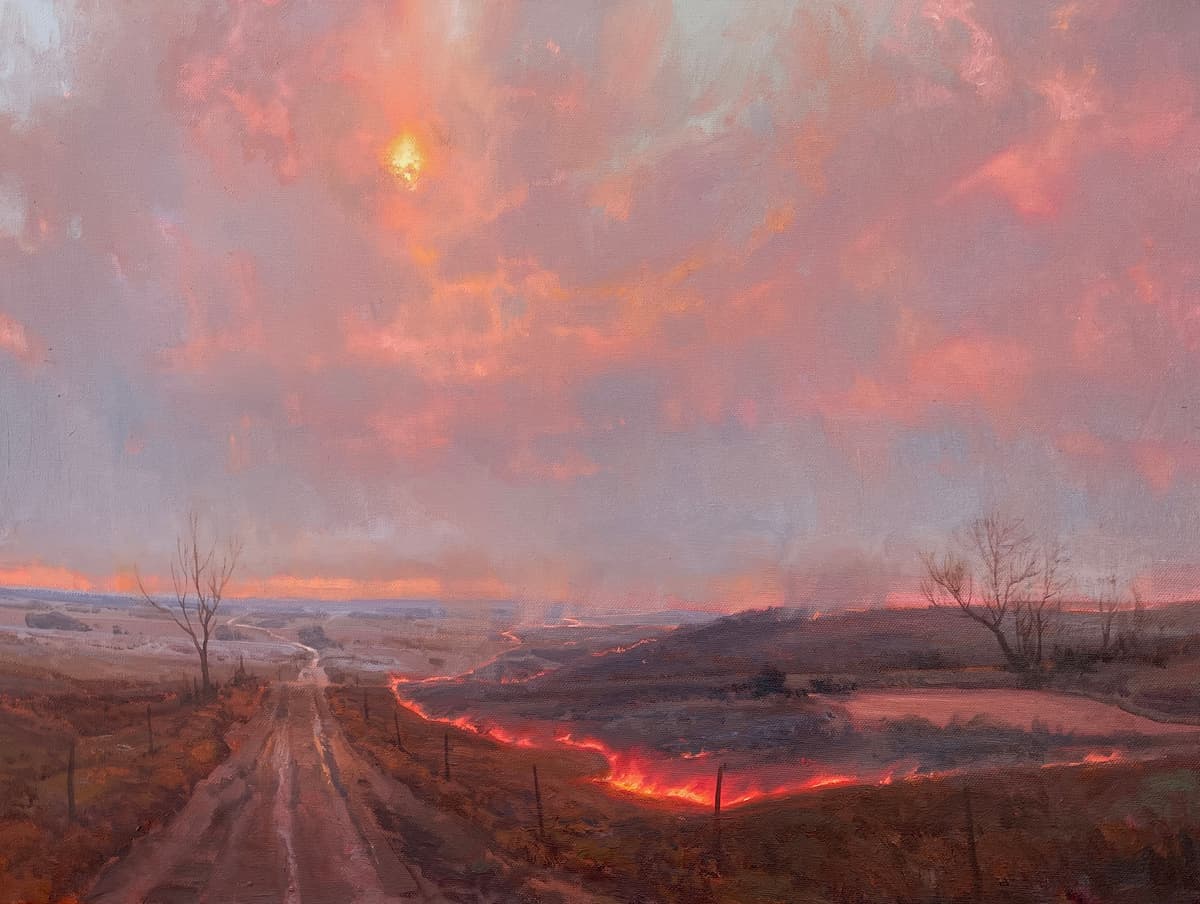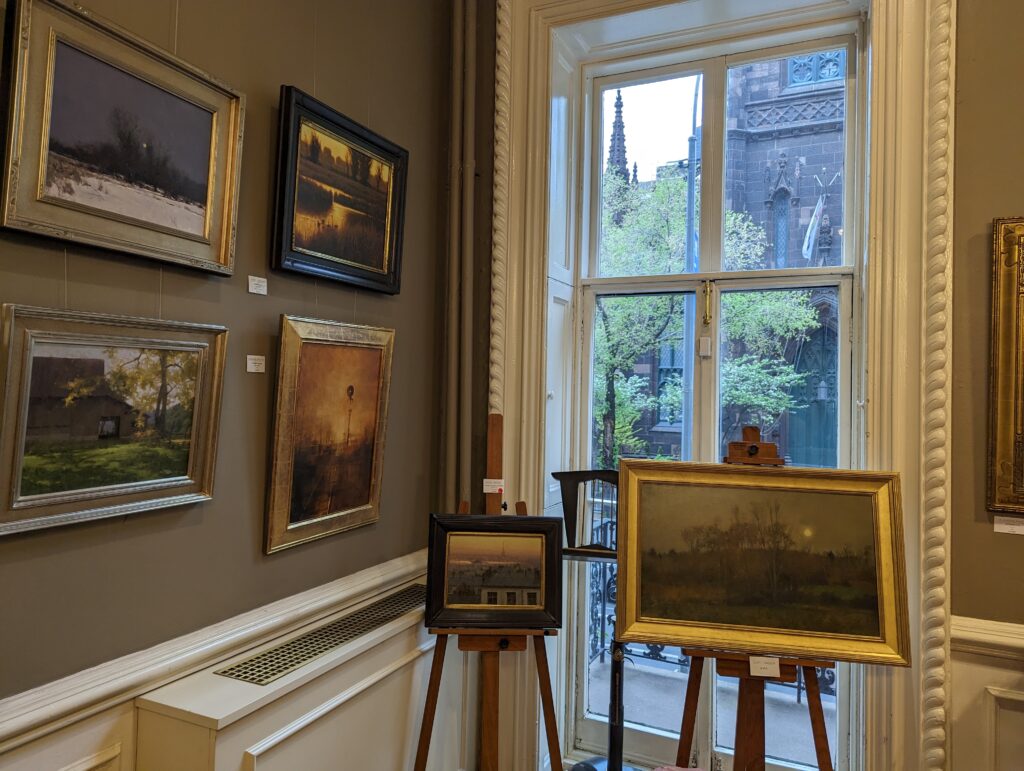A Well-Timed and Brilliant Exhibition of American Tonalists Offers Shades of Gray and Rosy-Fingered Dawns
There are no dogs — but there is plenty of bark — in this celebration of nature and her tones.

In well-timed contrast to climate activists who claim to defend nature by defacing art, the American Tonalist Society is presenting a painting exhibition in which reverence for nature is defended in limitless — and lovely — shades and majestic glory. Rosy-fingered dawn, as well as purple-edged marshes, sun-dappled creeks, and assorted scenes that expand the tradition of tonalism are on view at the Salmagundi Club through May 7 in “Shades of Gray: II.”
Founded in 2016, the American Tonalist Society is devoted to a style of painting defined in the 1800s as primarily landscape and reverential toward nature, with a spiritual gloss. Painters working in this style create a mood, rather than a story, through the tonal quality of a chosen color. Animals are rare. People, even rarer. In the 67 paintings of this exhibit, the only human form I spotted was in a painting of a statue presiding over a gray-green Paris courtyard in “The Old Master.”
That work is by Richie Carter, whose paintings stand out in this exhibition because his (empty) Parisian streets are among the few works that acknowledge man’s intrusion into nature. Brian Sindler’s hushed and blue “Nocturne, Grenwald” offers a bird’s-eye view of an industrial city that is surely not half as beautiful as it is represented here. Charlie Hunter’s “Turner Signal” is an orange-red, haunting evocation of a desolate stretch of train track.
“Turner Signal” gave this viewer a new image to consider as the “Valley of the Ashes” in “The Great Gatsby.” Heavy, hot, and powdery air surrounds. These man-made scenes, as well as surprising depictions of fire and fireworks, are not the traditional subjects of tonalism, but the exhibition’s organizers, according to a Society co-founder, Mary Erickson, decided to widen the genre.

This exhibition is the second biennial of the American Tonalist Society. The first was in 2019, and the group skipped one edition due to the pandemic. Founded by Daniel Ambrose, Eleinne Basa, Donald Demers, and Ms. Erickson, the group’s stated objective is “furthering the tonalist art movement and helping talented artists with strong technical skills thrive.”
By that measure, this show is a brilliant success and well worth a visit. Don’t be thrown off by the mention of “technical skills,” which suggests something more academic than what is on the walls of the Salmagundi Club’s elegant townhouse near Washington Square. These well-selected painters have the imagination, feeling, and skill to fire the senses of the viewer, an essential component of the tonalist aspiration.
“Blowing Snow in Buffalo County, WI” is a large-scale, masterful work by Ben Bauer, who indicates brutal wind sending snow against tree branches and a wooden fence. The chill is visible but subtle on this tidy farm. This is not gale-force wind that bends trees or conjures dramatic snow swirls. It offers just enough white puffs to merit a closer look, then give you a chill — and not just at the cold, but at the isolation of rural life.
Similarly, John MacDonald’s “Fading Ember” captures a winter sunset with care to avoid overdoing it. A low sun is setting on a short day, and summer feels incomprehensible. Mr. MacDonald was at the exhibition and mentioned that his work is done both en plein air and in the studio, as he chases the transitional moments of outdoor light. Be it the sun or moon, rising or setting, natural light changes too quickly to finish a painting.
In this exhibition, the moon seems to attract the painterly imagination more than the sun. Although that may have been the pull of “Winter” by Nancy Bush, who placed what appears to be the moon in the lower third of her painting and gives the rest to a giant sky, mottled in colors of moss green and deep lavender.
Maybe that color should be “deep purple,” but that would evoke the rock band — and there is already a painting in this exhibit titled “Three Dog Night.” Which is in fact a zero-dog night. Instead, artist Kim Lordier captures a snowy, shadowy edge of a marsh dotted with thistles or reeds.
Speaking of plants, unforgiving flora is preferred here. Blooming flowers would mean too many contrasting colors, whereas brambles, branches, and twigs allow for more monochromatic exploration. David Sharpe’s captivating “The Logging Road” looks out onto a wide field of heavy brown, sliced by a light orange road with a deeper orange emanating from the sky.
Anna Wainwright’s “In the Weeds” is perfectly titled: This is a neglected edge of a stream that one passes along in a canoe — on one’s way to enjoy a lake with swimming, fishing, and grand vistas. To get there, one paddles on, past the tangle and toward the fun, but Ms. Wainwright lingers to ask, “What lurks in those sun-baked, brown weeds?”

